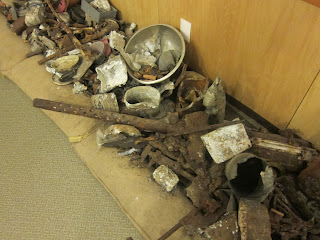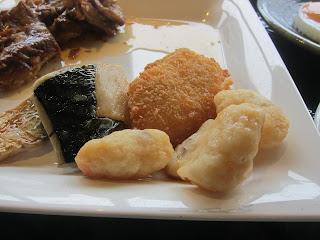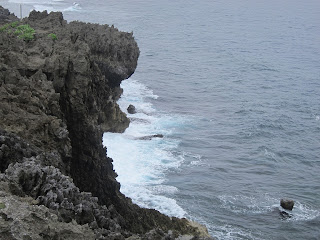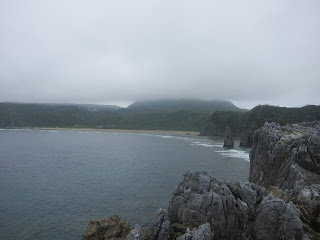Where was I? The after the drive to the end of the island, I had an appointment to meet Tsugiko Taira, curator of the
Haebaru Town Museum. It was a 10 AM appointment. Getting to Haebaru was a project to which I devoted several hours of research at the computer and at the Naha Bus Terminal. It was going to take only one bus, along with the monorail, but a long ride (17 stops/30 minutes) with calls being made in a language I don't understand, early in the day, probably with a lot of people. Daunting under the best of circumstances. On this day the rains finally came. I am prepared for rain. I brought an umbrella and heavy-duty pancho. While I was eating breakfast, the weather didn't look too bad out the window. It looked like I wouldn't even need the pancho. Oh boy! When I went downstairs...cats and dogs. I tried. I went out from under the awning for about three yards. I was soaked so bad I just turned around and went back into the lobby. It didn't look like things were going to change, so I determined to take a cab.
========================================================================
Okay, I had to stop. I think I had to go to sleep. I don't remember and I don't have access to what I wrote to get a bearing.
It has been several days since I started this posting. Right now I am on the stern observation deck of the ferry to
Rebun Island. It is cold and windy, but not so much so that I can't get a little work done. I am not going to adjust this to what I've already done when I get connectivity. Sorry. Also, it may be at least two days before any of it gets published. I don't know what kind of access I will have on Rebun. Even if I have it, dealing with the blog may not be what I want to do. On the other hand, once it gets dark, there may not be much else to do.
Back to Haebaru. The Japanese like to consolidate villages into cities. A lot of other peoples do, too. It is a natural thing. Haebaru resisted. They refused. They are their own city within the city of Naha. Spunk. That explains a couple of things. For example, when I talked to the guy at the bus terminal about going to Hedo Misake, I told him that I also needed to check the buses to Haebaru. "Oh, Haebaru." Not much more than that, but there was a certain something about how he said it. The same when I said it to the cab driver. "Haebaru?" It could be my imagination, but I felt a little something.
The whole cab thing was very out. It was pouring. Pouring. I gave him the address on a piece of paper. I had forgotten that they use telephone numbers here to figure out where they are going. So I had to run back up to the room to get the phone number. That wasn't easy to negotiate since he didn't speak a lick of English. Now he's driving towards Haebaru, on the phone with someone at the office who is looking up the phone number. Turns out the phone number is no good. They find an English (quasi) speaking guy, puts him on the phone to me. I can't tell him much. I turn on my rented pocket wi-fi, find a webpage with the info. Unfortunately, it was not the webpage linked to from this post. The webpage I found gave the address for the old location, which he took me too. The phone number it had, turned out to be the FAX number, which is why he came back on the line telling me it was no good.
I got to Haebaru City Hall, called Tsugiko from there; she came and picked me up. I did have a colorful conversation with all of the staff in the City Hall front office (only one English speaker - quasi) because I thought I might just walk from there. They thought I was crazy. I was, because there was a deluge going on. Have I said that it was also about 78º F as this rain was coming down? I have posted only one photo of the water because I was taking through the cab window; it was too steamy for any clear shots.
A jump.
Okinawa used to be a separate kingdom. They had their own rulers, their own god, their own trading relations with other nations. In other words, they have their own culture. Many of them still aren't totally comfortable with the whole Japanese thing. There is an (under)current here. Near the end of the war, the Japanese army stationed a lot of soldiers here. At Haeberu they dug a system of tunnels. Eventually, during the Allied invasion, they turned those tunnels into the field hospital, pressed the school boys into service and forced the school girls to nurse the wounded. The museum is mostly about that. I didn't expect to be taken with it, but I was. The museum has a reconstruction of the tunnels inside the building. Tsugiko offered me a tour of the actual ones. I declined. I didn't need that. They still dig up shoes, combs, artillery shells.
Later, Tsugiko took me to lunch at a local restaurant. I got the real Okinawan soba, which I had been told was different. It is different. It is also delicious.
The Okinawans are not totally cool with the Japanese and they are definitely not cool with the Americans (military.)
 |
| Evidence of the deluge from the taxi window. |
 |
| Tunnel exhibition. |
 |
| Tunnel exhibition. |
 |
| The hole in the kimono is where shrapnel went through. It missed the mother wearing it, but it the baby she was holding. The child died five days later. |
 |
| Stuff dug up around Haebaru Town. |
 |
| House of the period. |
 |
| Couldn't say. I need to read more of the brochure. |
 |
| Okinawan soba. |
 |
| The concrete structure is a tomb. The Okinawans put all of the family (father's side) into one tomb. This was/is a big family. See the rain? That is light compared to what it was when I left the hotel. |
 |
| Tsugiko Taira and yours truly. |
 |
| I wasn't able to try them, I had made reservations at my favorite spot. |
 |
| You are familiar with this restaurant by now. |
 |
| This is an intense, aged (I think), creamy tofu. It has a flavor very reminiscent of cheese. I gained points by eating it. The sauce is loaded with a strong alcohol. |
 |
| This fish is gurukun. I was advised in an e-mail to try. It is part of Okinawa. Tasty. |





























































































